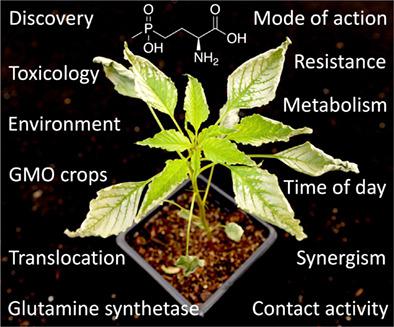当前位置:
X-MOL 学术
›
Pest Manag. Sci.
›
论文详情
Our official English website, www.x-mol.net, welcomes your
feedback! (Note: you will need to create a separate account there.)
Glufosinate-ammonium: a review of the current state of knowledge.
Pest Management Science ( IF 3.8 ) Pub Date : 2020-06-23 , DOI: 10.1002/ps.5965 Hudson K Takano 1 , Franck E Dayan 1
Pest Management Science ( IF 3.8 ) Pub Date : 2020-06-23 , DOI: 10.1002/ps.5965 Hudson K Takano 1 , Franck E Dayan 1
Affiliation

|
Glufosinate is a key herbicide to manage glyphosate‐resistant weeds mainly because it is a broad‐spectrum herbicide, and transgenic glufosinate‐resistant crops are available. Although glufosinate use has increased exponentially over the past decade, the treated area with this herbicide is far less than that with glyphosate. This is because glufosinate often provides inconsistent performance in the field, which is attributed to several factors including environmental conditions, application technology, and weed species. Glufosinate is also highly hydrophilic and does not translocate well in plants, generally providing poor control of grasses and perennial species. In the soil, glufosinate is rapidly degraded by microorganisms, leaving no residual activity. While there have been concerns regarding glufosinate toxicology, its proper use can be considered safe. Glufosinate is a fast‐acting herbicide that was first discovered as a natural product, and is the only herbicide presently targeting glutamine synthetase. The mode of action of glufosinate has been controversial, and the causes for the rapid phytotoxicity have often been attributed to ammonia accumulation. Recent studies indicate that the contact activity of glufosinate results from the accumulation of reactive oxygen species and subsequent lipid peroxidation. Glufosinate disrupts both photorespiration and the light reactions of photosynthesis, leading to photoreduction of molecular oxygen, which generates reactive oxygen species. The new understanding of the mode of action provided new ideas to improve the herbicidal activity of glufosinate. Finally, a very few weed species have evolved glufosinate resistance in the field, and the resistance mechanisms are generally not well understood requiring further investigation. © 2020 Society of Chemical Industry
中文翻译:

草铵膦铵盐:对当前知识状态的评论。
草铵膦是控制草甘膦抗性杂草的关键除草剂,主要是因为它是一种广谱除草剂,并且有抗草铵膦转基因作物。尽管在过去十年中草铵膦的使用呈指数增长,但使用这种除草剂处理的面积远远少于使用草甘膦的处理面积。这是因为草铵膦在田间经常提供不一致的性能,这归因于多种因素,包括环境条件,施用技术和杂草种类。草铵膦也是高度亲水的,在植物中不能很好地转运,通常对草和多年生植物的控制较差。草铵膦在土壤中被微生物迅速降解,没有残留活性。尽管有人担心草铵膦的毒理学,正确使用它可以被认为是安全的。草铵膦是一种速效除草剂,最初被发现为天然产物,并且是目前针对谷氨酰胺合成酶的唯一除草剂。草铵膦的作用方式一直存在争议,快速植物毒性的原因通常归因于氨的积累。最近的研究表明草铵膦的接触活性是由活性氧的积累和随后的脂质过氧化作用引起的。草铵膦破坏光呼吸和光合作用的光反应,导致分子氧的光还原,产生活性氧。对作用方式的新理解为提高草铵膦的除草活性提供了新思路。最后,极少数杂草在田间产生了草铵膦抗药性,并且对抗药性机理的了解还很少,需要进一步研究。©2020化学工业协会
更新日期:2020-06-23
中文翻译:

草铵膦铵盐:对当前知识状态的评论。
草铵膦是控制草甘膦抗性杂草的关键除草剂,主要是因为它是一种广谱除草剂,并且有抗草铵膦转基因作物。尽管在过去十年中草铵膦的使用呈指数增长,但使用这种除草剂处理的面积远远少于使用草甘膦的处理面积。这是因为草铵膦在田间经常提供不一致的性能,这归因于多种因素,包括环境条件,施用技术和杂草种类。草铵膦也是高度亲水的,在植物中不能很好地转运,通常对草和多年生植物的控制较差。草铵膦在土壤中被微生物迅速降解,没有残留活性。尽管有人担心草铵膦的毒理学,正确使用它可以被认为是安全的。草铵膦是一种速效除草剂,最初被发现为天然产物,并且是目前针对谷氨酰胺合成酶的唯一除草剂。草铵膦的作用方式一直存在争议,快速植物毒性的原因通常归因于氨的积累。最近的研究表明草铵膦的接触活性是由活性氧的积累和随后的脂质过氧化作用引起的。草铵膦破坏光呼吸和光合作用的光反应,导致分子氧的光还原,产生活性氧。对作用方式的新理解为提高草铵膦的除草活性提供了新思路。最后,极少数杂草在田间产生了草铵膦抗药性,并且对抗药性机理的了解还很少,需要进一步研究。©2020化学工业协会































 京公网安备 11010802027423号
京公网安备 11010802027423号